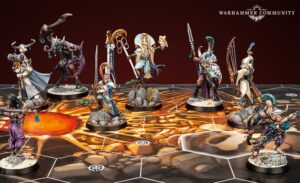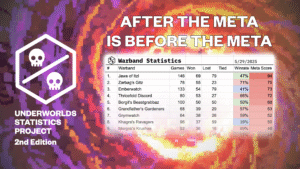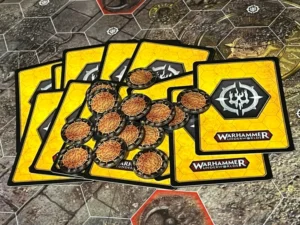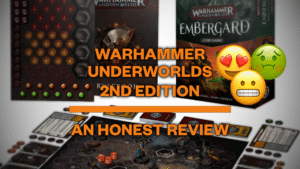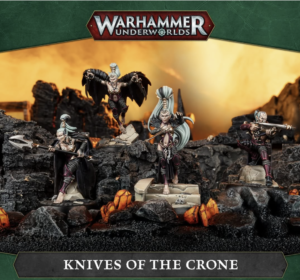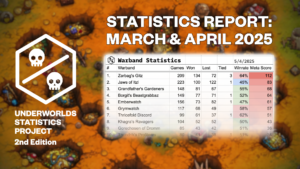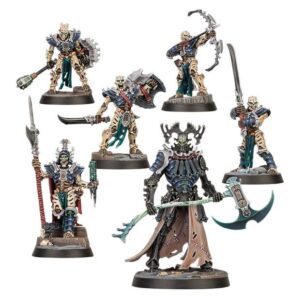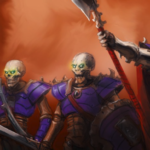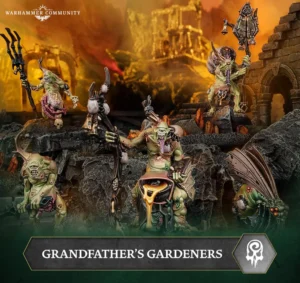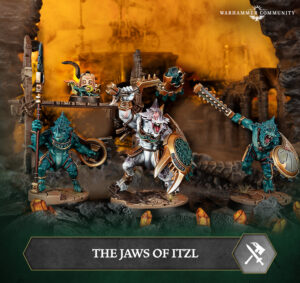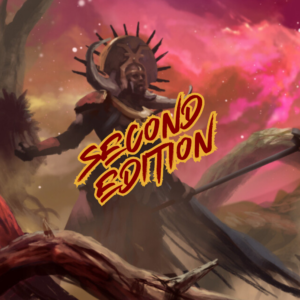Intro
Hello and welcome back to Path to Glory for another Rivals deck review! Today’s fare is the Edge of the Knife deck, only our second deck with a plot card to come out in the new edition! Outside of the rule it introduces for the deck itself, this notably means that we have our first ineligible Nemesis pairing in the edition (with Countdown to Cataclysm), as you cannot mix two decks which have a plot card. Still, this does add 5 brand new potential combinations to the Nemesis meta and of course gives us that 7th option for playing straight Rivals. As far as the deck itself, this one has been branded as our second Flex deck, which is a welcome addition considering that Strike has already had quite the time in the sun for the brief period where it was essentially the only playstyle that had the ability to double up when building a Nemesis deck (Mastery, again, is not a playstyle). Before we get started, since it has been a while since I’ve written a Rivals deck review, let me just put a brief reminder here of how my card grading system works:
Power Ceiling – Power output when drawn and/or played at the opportune moment(s) of a game
- 1 = Effect of card is minimal. Most other cards will provide more value in the same game state.
- 2 = Effect of card is average. Will provide decent utility, but it doesn’t do quite as much as the top dogs.
- 3 = Effect of card is significantly above average or even overpowered. Game state is significantly altered by its effect.
Consistency – Frequency with which a card is expected to provide value at or near its power ceiling
- 1 = Power level is highly dependent on game state and draw sequencing. Card will work infrequently and/or has a wide variety of expected outcomes.
- 2 = Power level is somewhat dependent on game state and draw sequencing. Card has a narrower range of expected outcomes, but is not a guarantee.
- 3 = Power level is relatively independent of game state and draw sequencing. Card will almost always work as desired.
Universality – General appeal and ubiquity (does not apply to Warband-specific cards)
- 1 = Card is situational and designed to be played only by very specific playstyles/warband choices (if any).
- 2 = Card could potentially find its way into any deck, but returns more value on a handful of playstyles/warband choices.
- 3 = Card value is relatively independent of playstyle or warband choice.
Plot Card
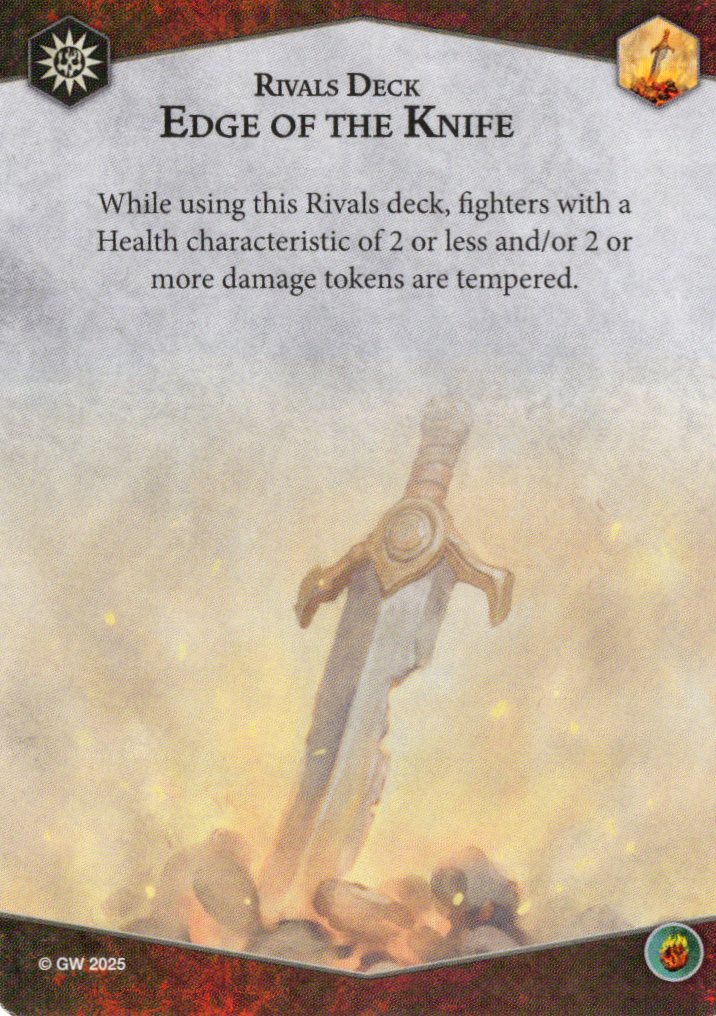
Perhaps the simplest plot card we have ever seen, it simply defines what a “tempered” fighter is, as this is the pseudo-keyword that is referenced in many of the cards throughout the deck. Tempered fighters are those who have a Health characteristic of 2 or less and/or have 2 or more damage tokens on them. At first glance, the easy thing to say is that this makes the deck a natural choice for horde warbands where you have many fighters that already satisfy the criteria for being tempered. Of course, that is a great immediate synergy, but the “backup” plan so-to-speak of just having 2 damage on a more elite fighter means that the deck is still accessible for everyone, especially in the context of pairings with self-ping cards like Scream of Anger. While I do think you will still like to have at least a couple fighters in the warband who begin the game tempered to get the most value out of the deck, I don’t believe you should outright dismiss it if you are playing a more elite squad, especially in cases where you might consider dipping into the deck only for cards which don’t care about the tempered status or for particularly powerful effects you might access once you’ve become tempered.
Objectives
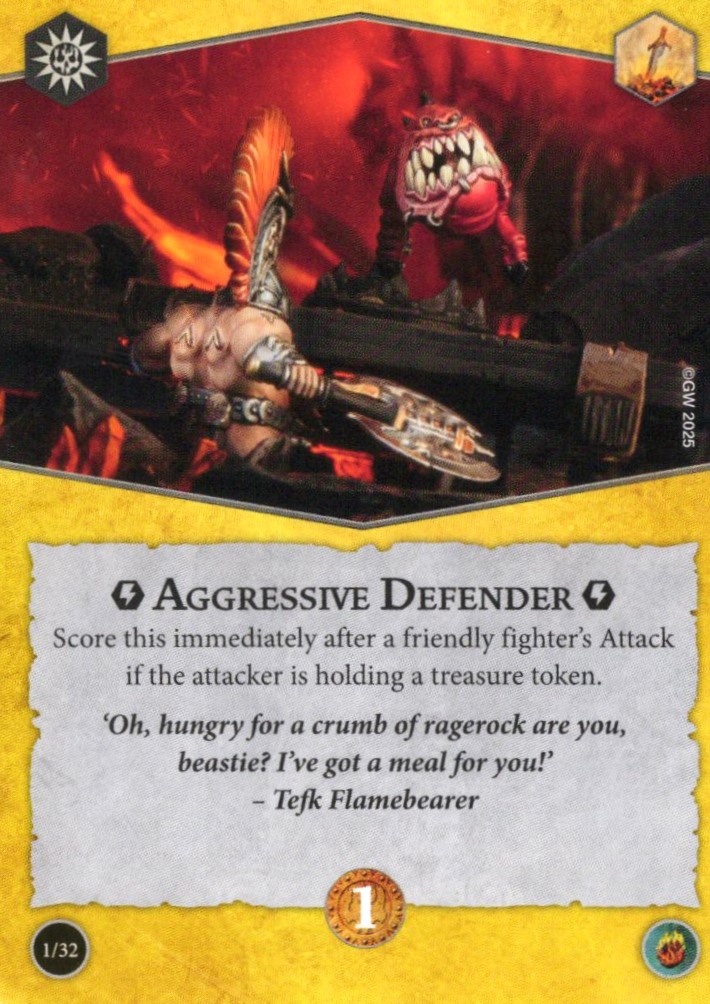
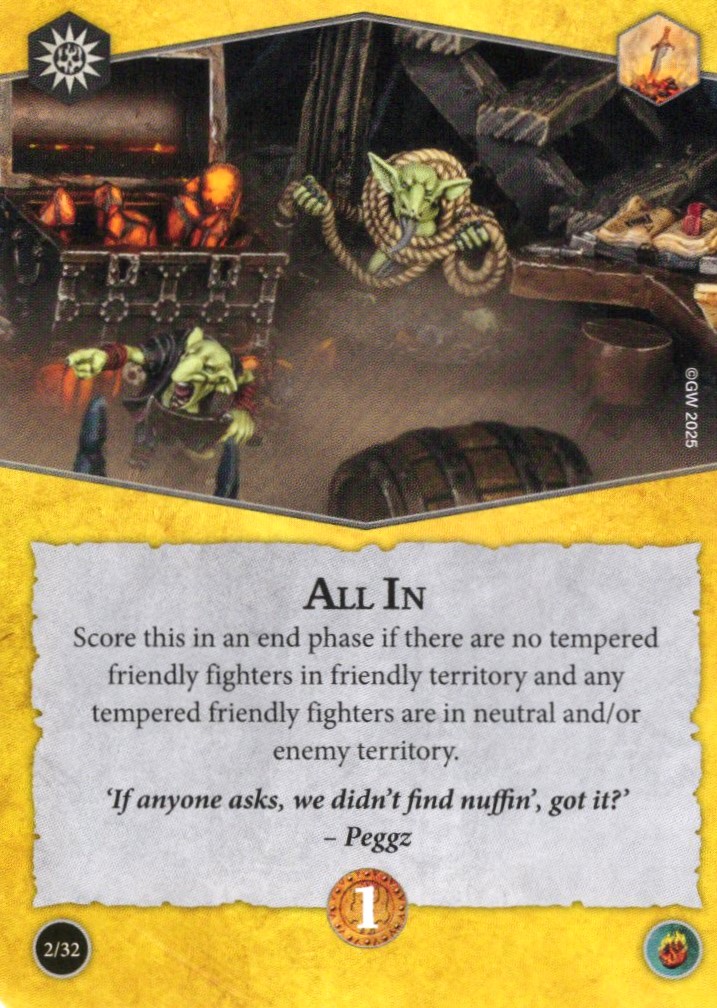
Speaking of tempered-agnostic effects, we’ve got a familiar face here with Aggressive Defender, which is not only the best surge objective we saw in the Emberstone Sentinels deck (low bar, I know), but is one of the most consistent surge objectives in the game. You generally want to have fighters with Range 2+ attacks to make it more reliable, but the fact that it cares only whether the attack was made rather than if you hit or rolled any specific symbols means that any Flex warband should be doing this as often as possible every single game, even those with predominantly Range 1 attacks. Easy auto-include and should basically be a free seed glory every time it enters your hand. Just be mindful that it does require treasure tokens specifically.
Power Ceiling: 3, Consistency: 3, Universality: 2
Our first end phase for the deck is All In, which, as the name implies, really wants you to push forward into enemy/neutral territory, as you score it if you have no friendly tempered fighters in your territory and have any (one or more) in neutral and/or enemy territory. This is one of the tempered-specific cards that actually lends itself much better to an elite warband than a horde, as hordes will often struggle to vacate their territory, if they even want to play that way. That said, there are still much easier 1-glory end phases out there. I think this card was a bit dead on arrival, as it would arguably be too easy for a 2-glory end phase for elite aggro warbands, but is just much too difficult for hordes short of the third (or maybe the second) end phase. I’m also not going to just leave my opponent unhindered if they want to be in my territory, I want the flexibility to chase after them without having to worry about bricking a 1-glory end phase.
Power Ceiling: 1, Consistency: 1, Universality: 2
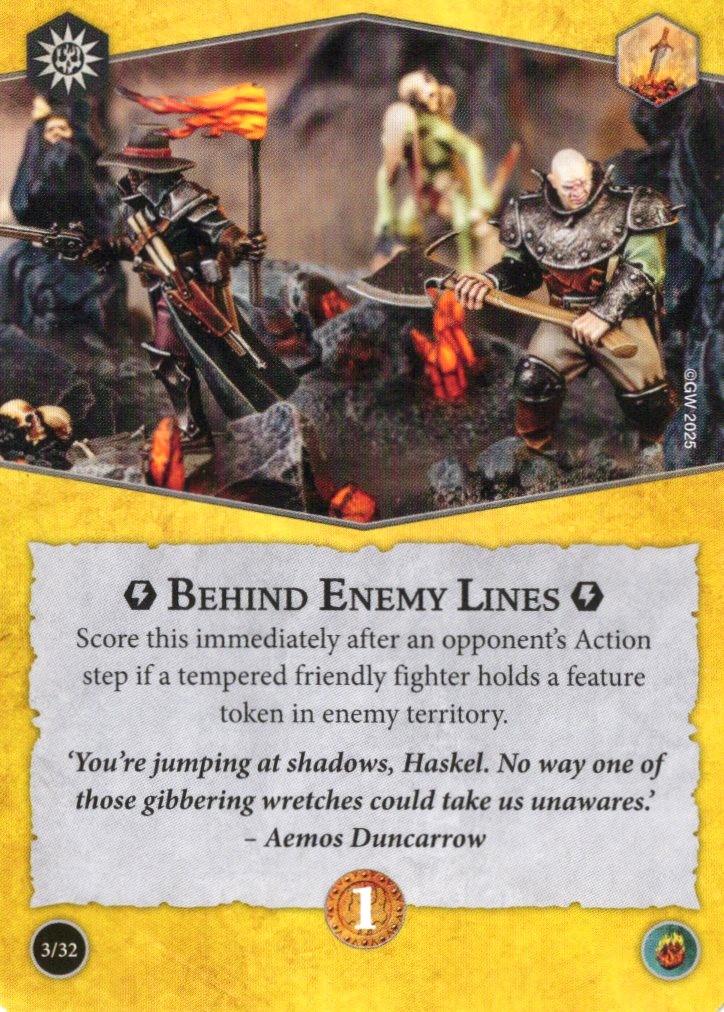
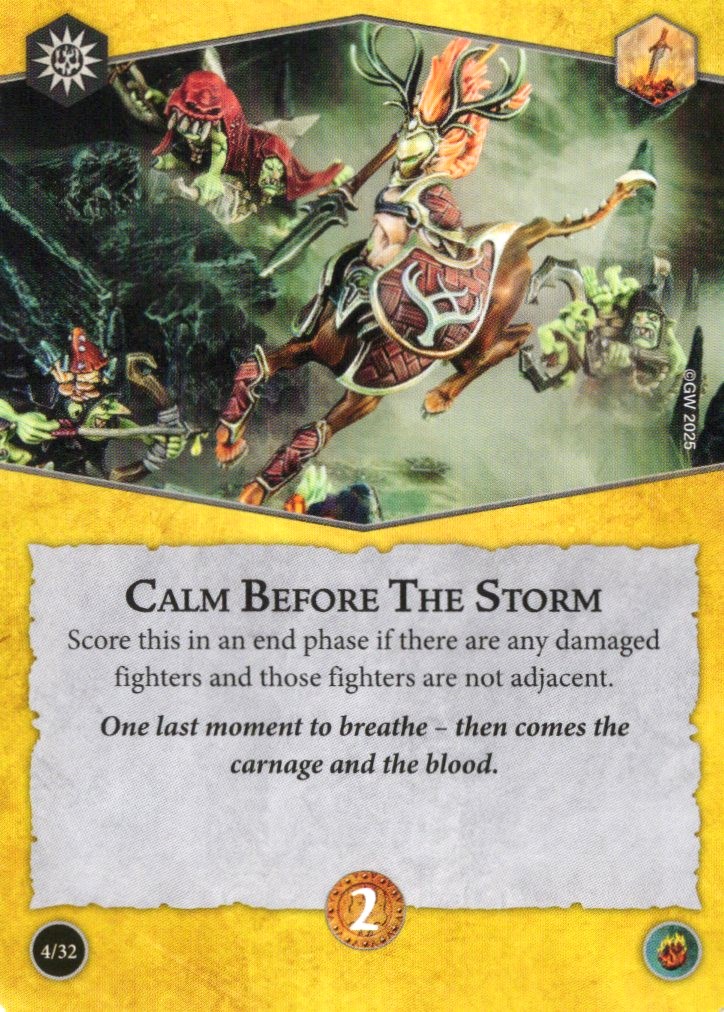
Behind Enemy Lines is our first tempered-specific surge objective, scoring after an opponent’s action step if a tempered friendly fighter holds a feature token in enemy territory. While I think this is mostly better than the “hold in enemy territory” surges we saw in ES, particularly because it does not specify treasure tokens, I just generally take issue with being forced to hold tokens in enemy territory with how the board set up rules force you to place the first token in neutral territory. Unless I am playing some version of invading aggro (an old 1st edition term meaning that you want to run into enemy territory and stand on tokens; less reliant on whether your attacks hit), many of my flex builds so far in the second edition really want to have two tokens accessible in my own territory, which leaves me little opportunity for deliberately placing one in my opponent’s, especially if I happen to be the one placing 3 tokens and they have a chance to disrupt me. It is not bad, and I did mention on a recent Patron episode that I think invading aggro is going to be a thing again, I just think this looks more like a cut 7th surge than it does a staple.
Power Ceiling: 2, Consistency: 2, Universality: 2
Calm Before the Storm is an interesting take on Alone in the Dark where, instead of no fighters being adjacent, you are just aiming to have any damaged fighters not be adjacent. Note that this card does include both friendly and enemy fighters. I do think it needs a couple of FAQs, but I am going to assume some things for the sake of the analysis. Firstly, I am going to assume (based on how Lost in the Depths has been played so far) that the adjacency it is referring to is damaged fighters being adjacent to other damaged fighters, not adjacent to just any fighter. Secondly, I am going to assume that if there is only one damaged fighter on the board, piggybacking off my last assumption, you score this card guaranteed. If my assumptions are correct, this is an incredibly strong 2-glory end phase, as even horde vs. horde matchups where fighters tend to just get one-shot rather than damaged will still usually have one or two stronger fighters in play who can take a hit and stick around. I basically view this as a strictly better version of Alone in the Dark since it is checking for a (generally) smaller subset of fighters to meet the condition with minimal investment to ensure the damaged condition is satisfied. While not automatic, I think it will be much harder to stop in practice than one might expect, particularly since we no longer have lethal hexes printed on the boards to manipulate your damage status. Furthermore, pairing with self-ping cards such as those in Wrack and Ruin can further bolster your odds of scoring this “on demand” even in cases where your opponent was being careful to make sure damaged fighters were being slain. Obviously, if either of my assumptions about how the card works (particularly the first one, since it begets the second) turn out to be incorrect, my rating would drop significantly, but for now I can’t help but imagine you take this in most, if not all Edge of the Knife Nemesis builds. If my understanding is correct, even warbands that generally like to cluster up (Kainan’s Reapers, for example) should generally have the ability to play for this.
Power Ceiling: 3, Consistency: 2, Universality: 3
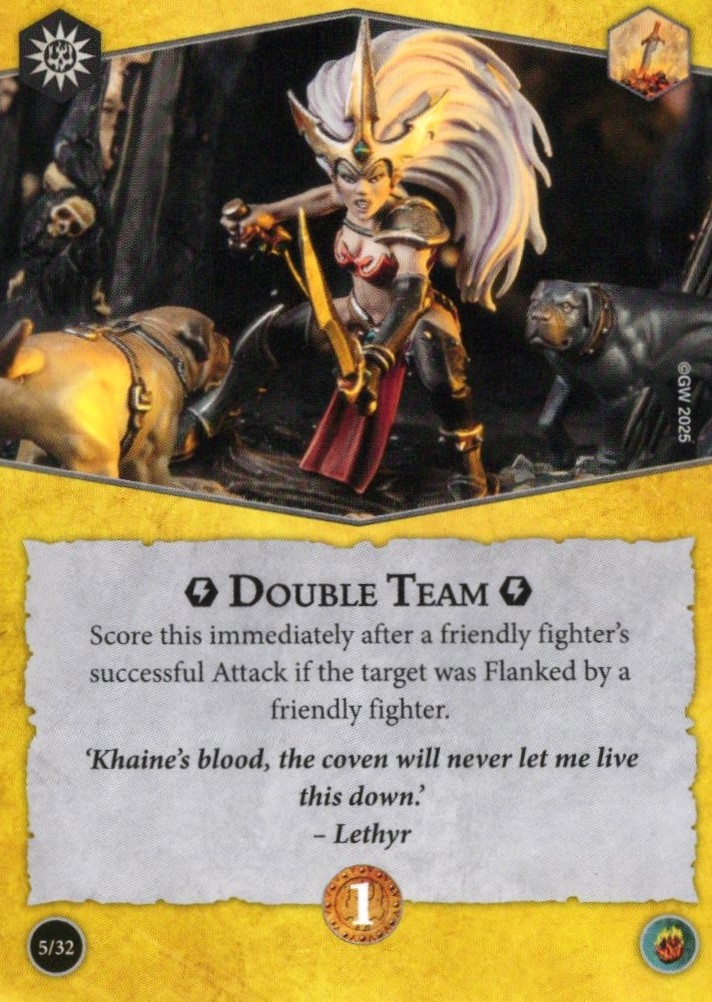
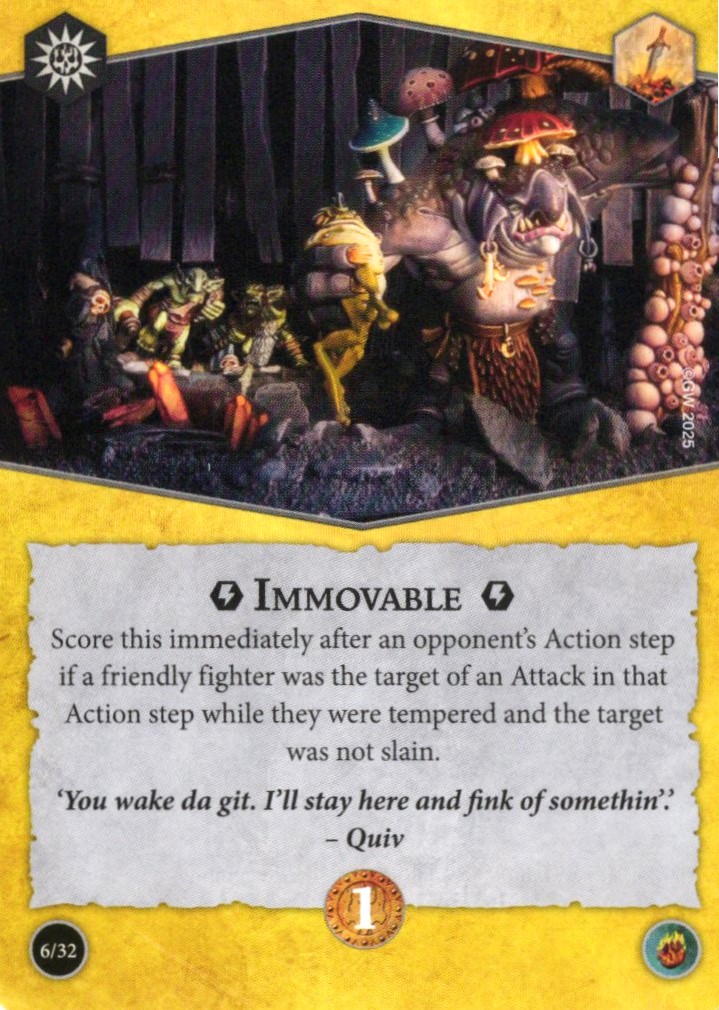
Double Team is another tempered-agnostic surge, simply requiring you to make a successful attack where the target was flanked by a friendly fighter. Importantly, the way this is worded means that cards like Hidden Aid will not help you score this since they just give you the “state” of having flanked, there is not a friendly fighter doing it for you. Still, some warbands do this kind of thing all the time anyway, most notably Zarbag’s Gitz, who get to move in a support during most charges they would plan to make. This is also a nice way to punish greedier Strike players who are often willing to charge into a flanked state just to swing a particular fighter. Of course, there is the counter argument to be made that you not only need to set something up but also need to land the attack, which is not the case for many other “make an attack” surges (Critical Effort, Branching Fate, Get Stuck In, etc.). From that perspective I think this card is perfectly respectable, but I could see instances of it getting pushed out of the deck in certain Nemesis pairings.
Power Ceiling: 2, Consistency: 2, Universality: 2
Immovable is the next surge in the deck, this one for a tempered friendly fighter being the target of an attack and not being slain. Note that they need to have been tempered at the time the attack was initiated, but this is still insanely good. For some warbands, this is darn close to “your opponent missed an attack, score a glory,” which is wild in its own right. On top of that, you can still score it even if they hit, so long as the fighter was not slain. Short of your opponent only taking very high odds swings that will one-shot your tempered fighters (which is a big ask, particularly in the early game), there’s not too much control they have in denying you from scoring this. The only downside is that you may get a bit stuck against more passive opponents or if your opponent’s dice happen to hit a hot streak. I will say, this is one I would definitely want to have tempered fighters in the warband for by default so that I can have it potentially come online as early as the first turn.
Power Ceiling: 3, Consistency: 2, Universality: 2
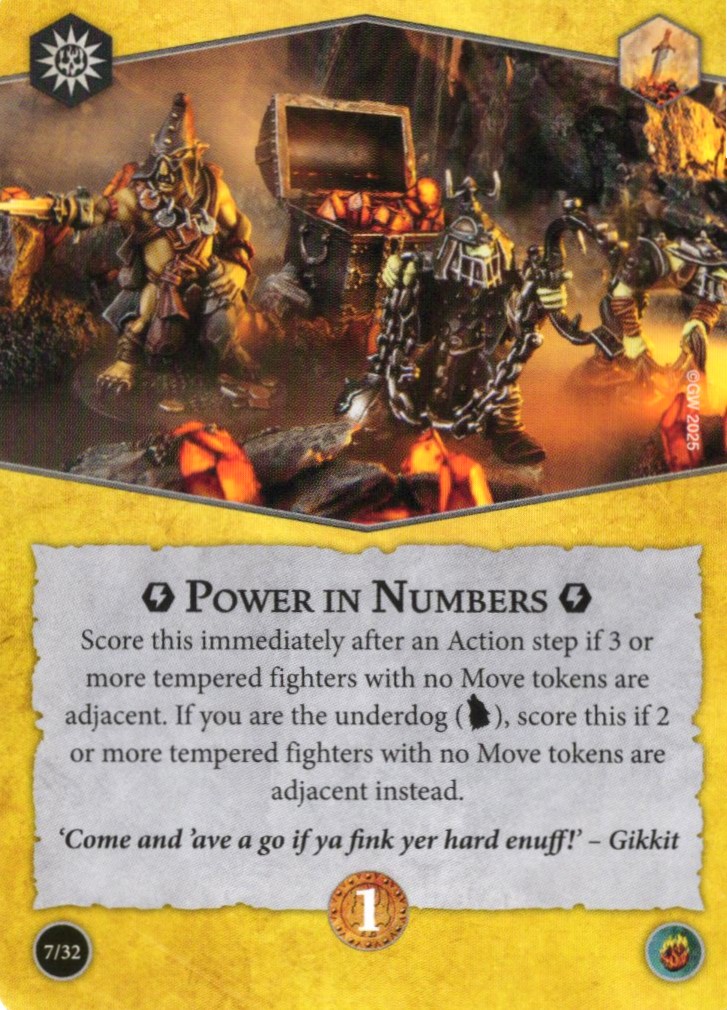
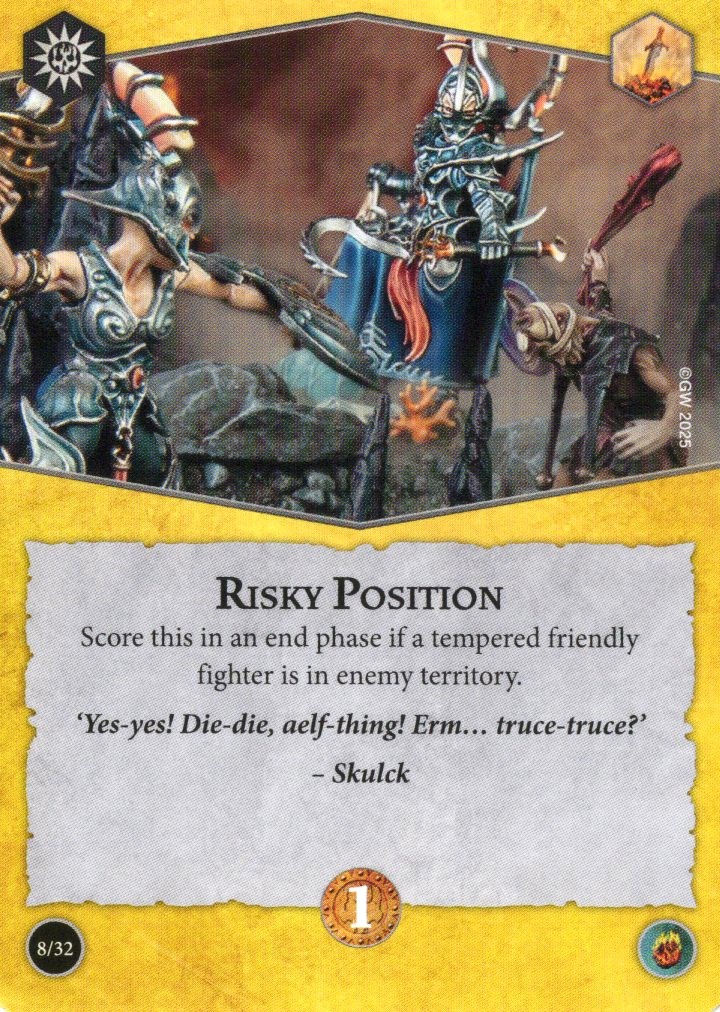
Continuing the surge train, we have Power in Numbers, a very odd surge that requires you to have 3 tempered fighters without move tokens adjacent to each other, or 2 if you are the underdog. Based on how Vicious Brawl has been ruled, this does mean that all 3 will need to be standing in a little triangle to score this when you are not the underdog, making Zarbag’s Gitz the only clear and obvious choice for this card, being that they are the only ones who can achieve this construct on deployment. Even so, this feels pretty draw dependent, as the no Move tokens aspect of this will make it pretty difficult to set up short of some clutch pushes (where is Centre of Attention when you need it?!). If everything lines up just so, this is a great passive score, but if this isn’t in your hand at the start of a round, I think you will often have trouble trying to score this except as the underdog, I think you skip this one more often than not.
Power Ceiling: 3, Consistency: 1, Universality: 1
Risky Position scores in an end phase for having one or more tempered friendly fighters in enemy territory. While not a guaranteed score, this is a pretty consistent 1-glory if your gameplan generally revolves around pushing into enemy territory. Grymwatch stand out in particular for their ability to raise during a power step directly into enemy territory, but this is just generally hard to stop if you are committed to the gameplan, especially in cases where you are playing on the “wide board” setup.
Power Ceiling: 1, Consistency: 3, Universality: 2
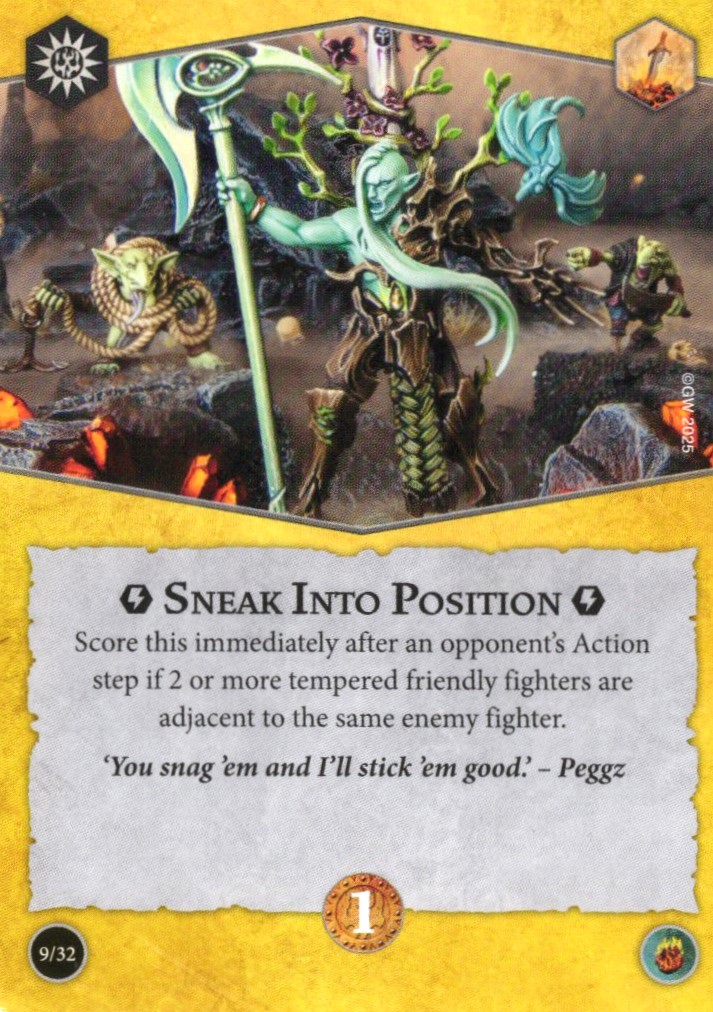
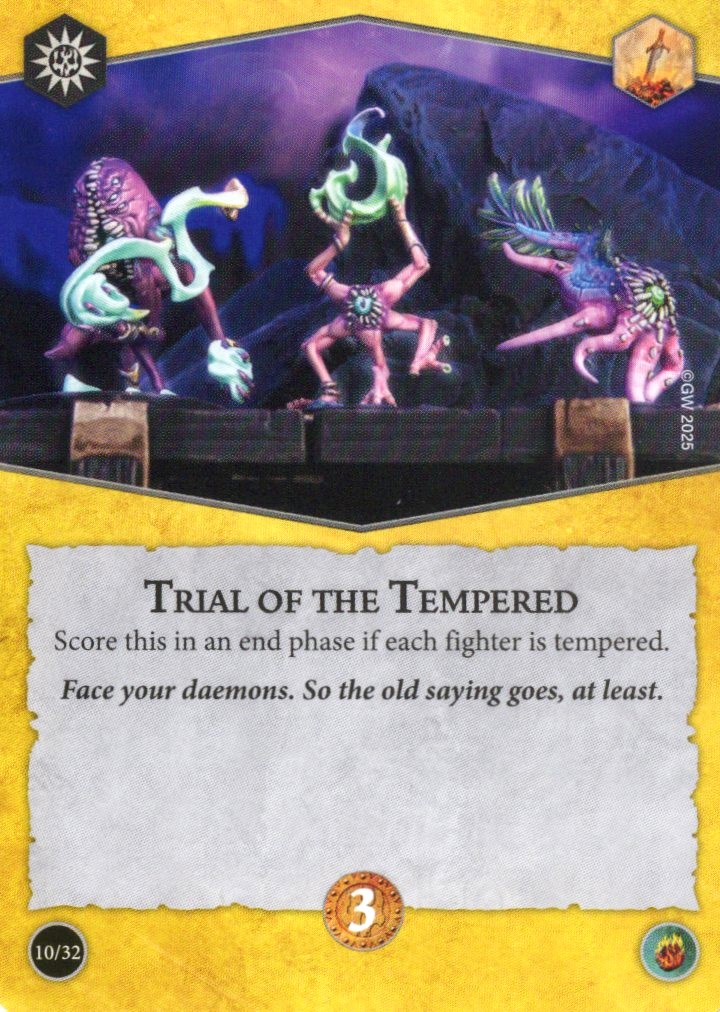
If you’re counting, you’ll know Sneak into Position is our last surge objective, scoring after your opponent’s action step if two or more tempered friendly fighters are adjacent to an enemy fighter. Since you probably know my feelings on giving up support to my opponent on clap-back attacks, you can already guess that I don’t love the idea of this card. It sort of reminds me of Scrum from back in the day, but needing it to be after your opponent has a chance to respond makes it a lot less desirable for me. The one niche case that comes to mind off-hand is with the use of Dire Ultimatum on Kainan’s Reapers, as you could conceivably Mortek Advance for the surround, deny your opponent from hitting your smaller guys and score the card. However, even then, a canny opponent ought to see what you are going for and could very conceivably ruin the plan by pushing, moving, or charging away. I have a hard time imagining this fits into many Nemesis decks.
Power Ceiling: 2, Consistency: 1, Universality: 1
Trial of the Tempered is the big 3-glory bomb of the deck, scoring in an end phase if every surviving fighter is tempered. While holding up your end of the bargain on this will be pretty consistent (particularly for certain warband choices), this obviously has a lot of matchup dependence to it. If this Rivals deck becomes very popular, it has a bit of that Voidcursed symmetrical scoring vibe in that scoring becomes almost inevitable and/or both players will score it if they both have it. However, it is practically an untenable amount of work in other matchups, particularly against things like Spiteclaw’s Swarm where none of their fighters start the game tempered and they can also resurrect non-tempered fighters. I think is ok if you are playing a very fight-and-die aggro strategy, but there are definitely better 3-glory scores available out there.
Power Ceiling: 3, Consistency: 1, Universality: 1
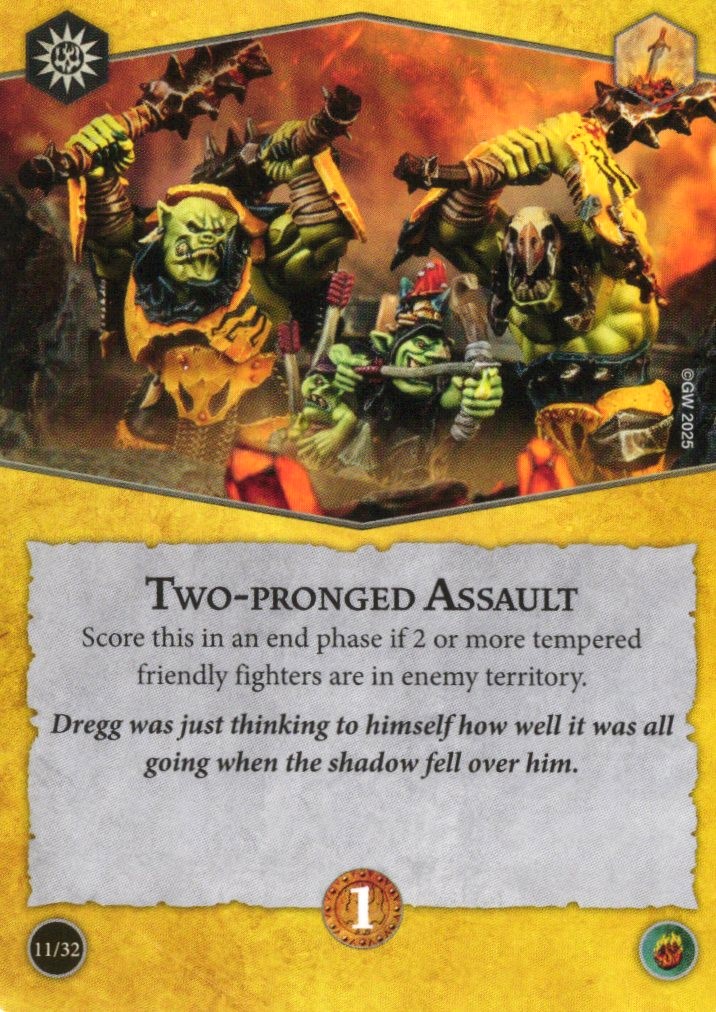
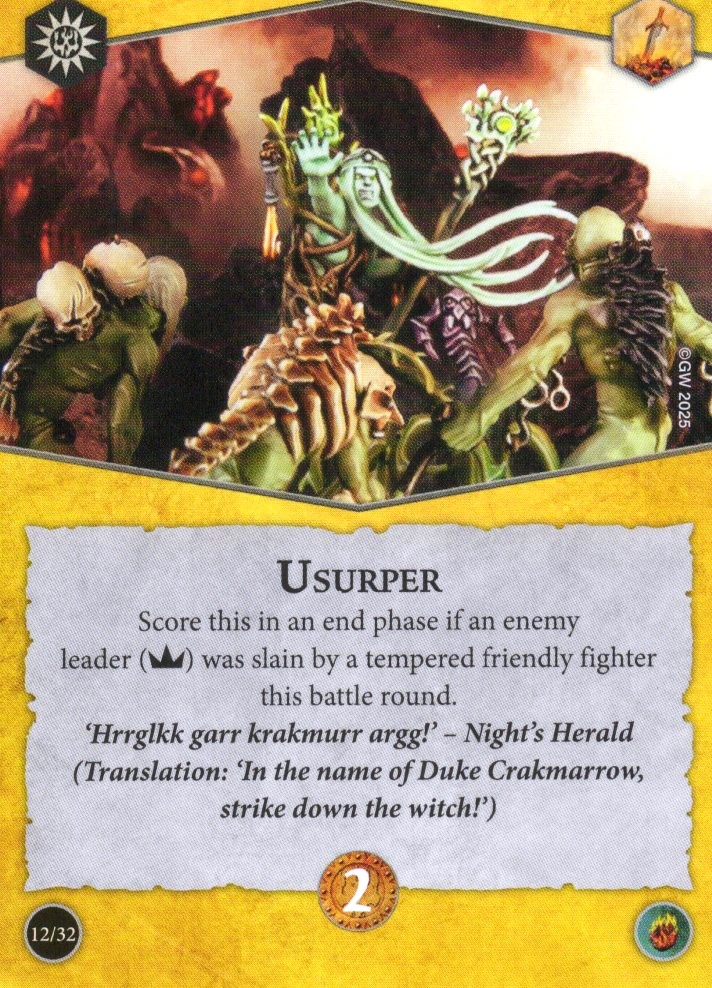
Two-Pronged Assault is just double everything except the glory payout when compared to Risky Position, which is a major “leave it on the shelf” for me. If this were 2 glory, which I don’t think would be outrageous, I’d have a much higher opinion of it, but unfortunately this is a bit of a symptom of the “every deck has to have 16 glory in the objectives” design space. Considering we’re about to see where they spent that second 2-glory slot instead, I have to say I really wish this had been the one to have that honor.
Power Ceiling: 1, Consistency: 1, Universality: 1
The last objective in the set is Usurper, which scores for 2 glory in the end phase if you slayed the enemy leader in the preceding action phase with a friendly tempered fighter. We’ve seen these kinds of cards before and I just have to say I’m really disappointed that we haven’t evolved out of this design space. I thought we’d turned a bit of a corner in Nethermaze when we started getting cards that simply required the enemy leader to be slain (often with an additional condition), but here we are again, hoping we can line up this enemy leader kill in the same round we draw the card. Sad to end on a sour note, but I think my disappointment is compounded by the fact that this ate the last available 2-glory slot in the deck and almost single-handedly causes the deck to finish with a below average end phase package.
Power Ceiling: 1, Consistency: 1, Universality: 2
Ploys
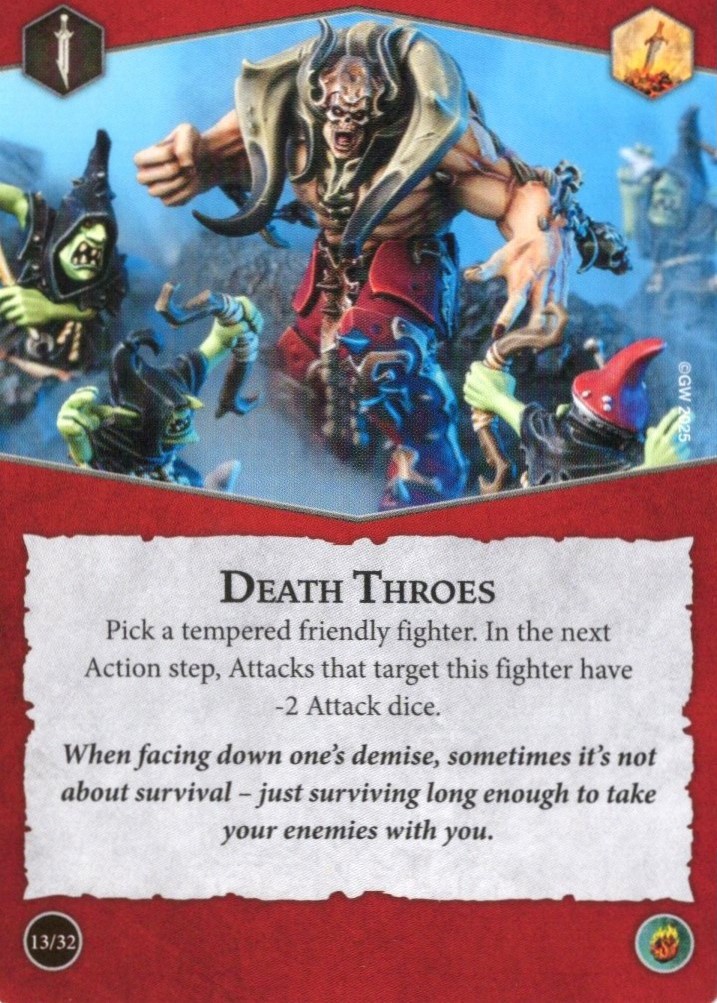
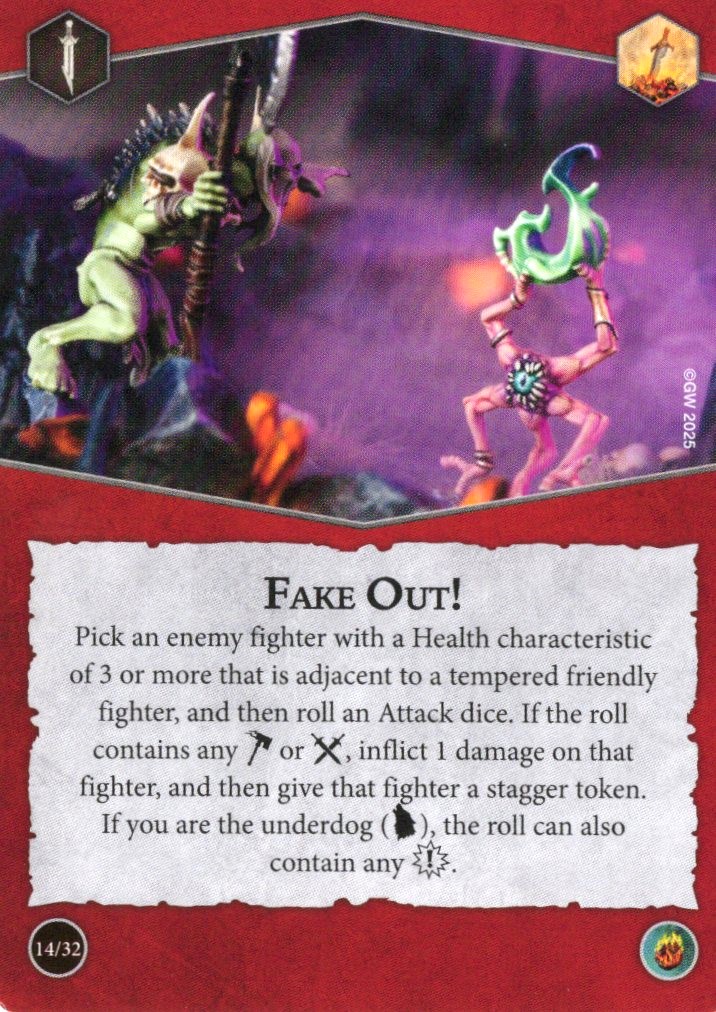
Starting off the ploys on a much happier note, we have Death Throes, which allows you to pick a friendly tempered fighter and give your opponent -2 Attack dice (to a minimum of 1 still, per the rules) when targeting them in the next action step. I like this one quite a bit in cases where you need to secure some positional scoring, and it is clearly intended to help support Immovable. While there are probably more straightforwardly powerful effects you could pack into your power deck, this is the kind of card that can compound with similar “delay” effects. If you drop something like Fireproof one turn, then this the next, then Reckless Attitudes or something where your opponent can’t execute a charge, you can really disrupt the flow of your opponent’s turns. Won’t make it into every deck, but there are definitely situations where this gets value.
Power Ceiling: 2, Consistency: 2, Universality: 2
Don’t flinch, it’s Fake Out! (Don’t mind me, just a little Pokémon humor from a past competitive gaming life). This one gives you a straight 50% chance to ping and stagger an enemy fighter adjacent to a tempered friendly fighter, or 66% if you are the underdog. Given the relatively high odds of failure, I’m glad not to see any restrictions regarding undamaged or non-vulnerable targets. The effect is obviously potent, but the lack of control over whether or not it works is a bit of a tough sell for me unless my Nemesis pairing underwhelms on ploy offerings. This one is going to be very build-dependent and I think I’ll often find myself reaching for a less potent, yet more consistent effect instead.
Power Ceiling: 3, Consistency: 1, Universality: 2
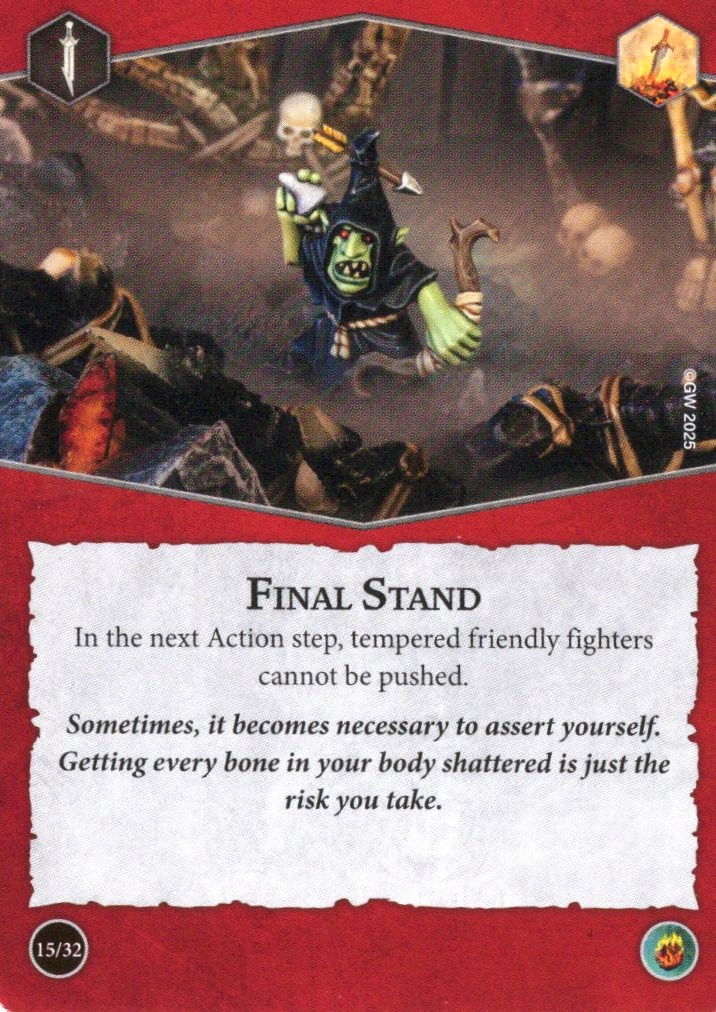
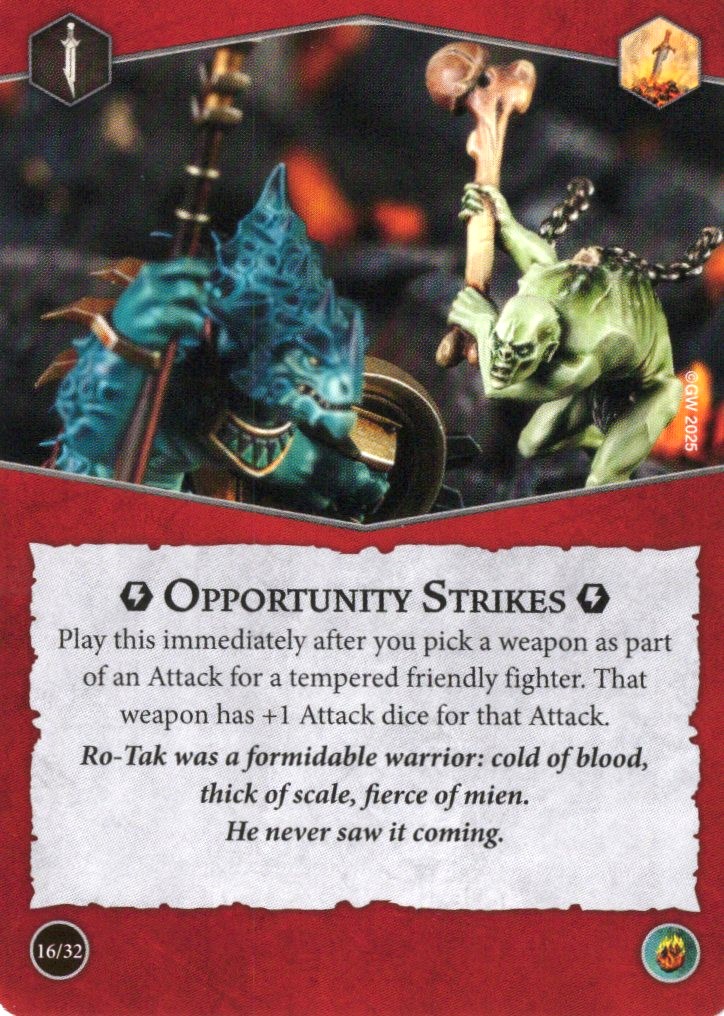
Next up is Final Stand, which prevents friendly tempered fighters from being pushed in the next action step. Cannot be pushed is a nice effect, but limiting this to just an action step is very unfortunate, I would have liked to have seen something more similar to Cool Heads in terms of effect duration so you could use this secure more than surge scoring, so I think you’re in a similar situation where you’d need a really poor set of ploys to choose from in your pairing to make this worth slotting into your deck.
Power Ceiling: 2, Consistency: 1, Universality: 2
While a strictly worse version of Determined Effort, extra dice is always a nice thing to see in a deck and Opportunity Strikes fits that bill. Notably, if you are pairing this with Blazing Assault you can certainly take and even use both on the same attack, while the redundancy is also nice to make sure you are landing those attacks early. I think this one makes it into most of your decks here, I like it a lot.
Power Ceiling: 2, Consistency: 3, Universality: 3
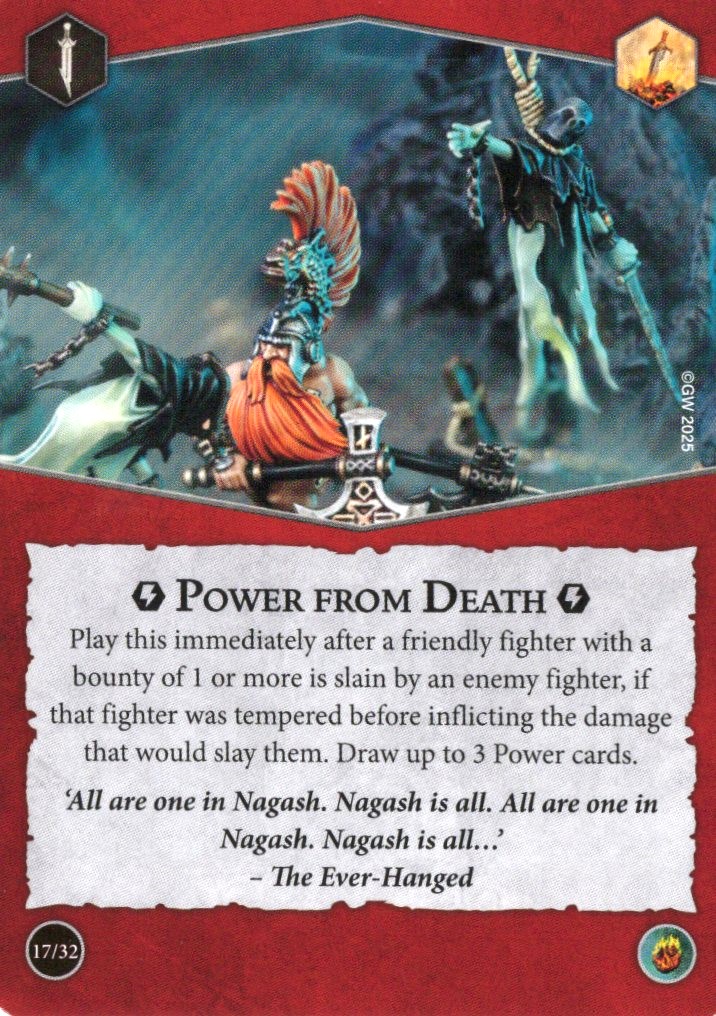
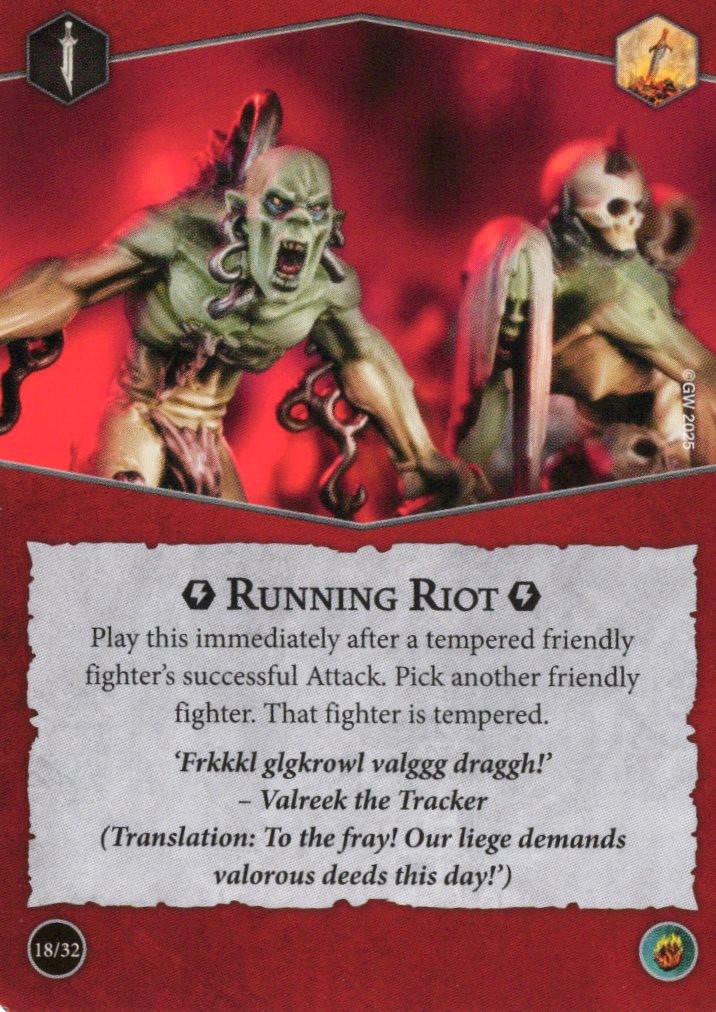
EDITED: Power from Death is this edition’s Dark Sacrifice. A few more hoops to jump through, but drawing a whopping 3 power cards is huge. With the Focus action and the extra potential cards on round roll-offs, this card alone can help you see your whole power deck in a game, even before factoring in potential warscroll card draw. Easy take for warbands with lots of weak, natively tempered fighters, which is probably the main audience for the deck in the first place. May not line up sometimes, but this is basically an autoinclusion. Note that it does not read as if it works for raised fighters, but still plenty good even for those warbands.
Power Ceiling: 3, Consistency: 2, Universality: 2
EDITED: Running Riot is a way to “spread” the tempered state to your non-tempered fighters. This can definitely work for those warbands where you have a lot of tempered fighters natively and just need to get one or two more on board with the game plan, but I have a hard time saying I would burn a valuable ploy slot just for that when I could take something that has an actual gameplay effect instead. I would also like some clarification on whether this lasts between rounds. RaW, it does not appear that it does so, which would make it even less valuable.
Power Ceiling: 1, Consistency: 3, Universality: 2
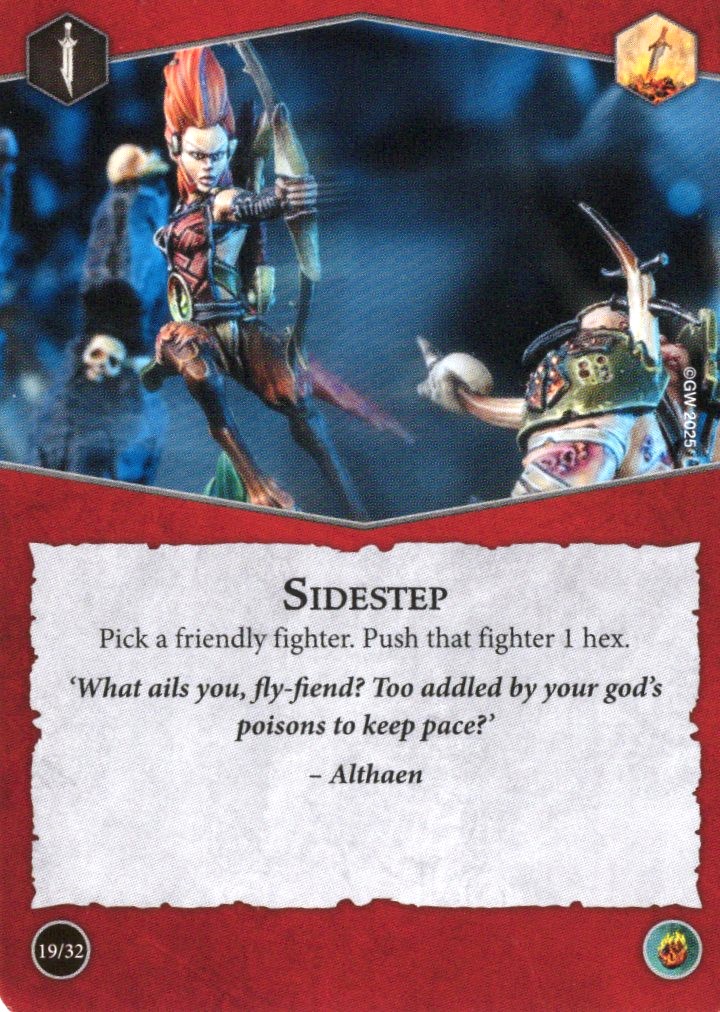
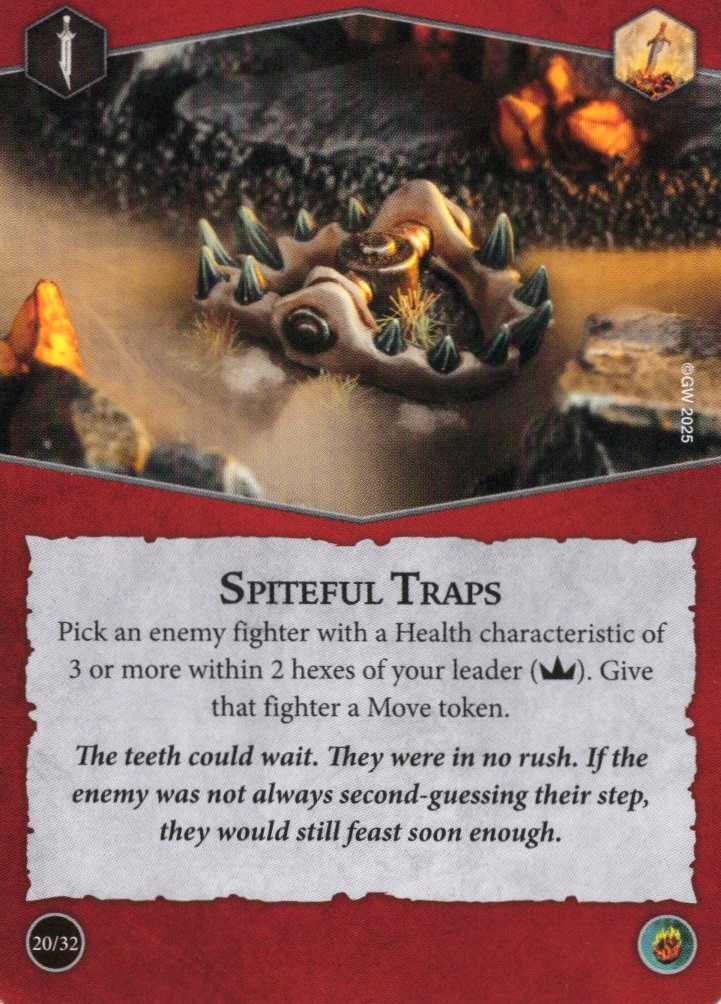
Sidestep is Sidestep. It’s always going to be good and I have a hard time imagining a Nemesis deck that wouldn’t take it if it is available in the pairing.
Power Ceiling: 2, Consistency: 3, Universality: 3
Another really neat control piece here in Spiteful Traps, which throws a Move token on a fighter with a Health characteristic of 3 or more within 2 hexes of your leader. With the number of teleports available in the game right now, I love this card. We talked earlier about how having a preponderance of cards in your deck that tell your opponent “actually, you don’t get to do what you were about to do” is a good thing and this one can be backbreaking at the right time, especially when it can be used to prevent your opponent from getting charged out. There’s obviously some risk of bricking in cases where your leader is slain, but I just don’t see how this isn’t going in your deck if you’re pairing with EotK.
Power Ceiling: 3, Consistency: 2, Universality: 2
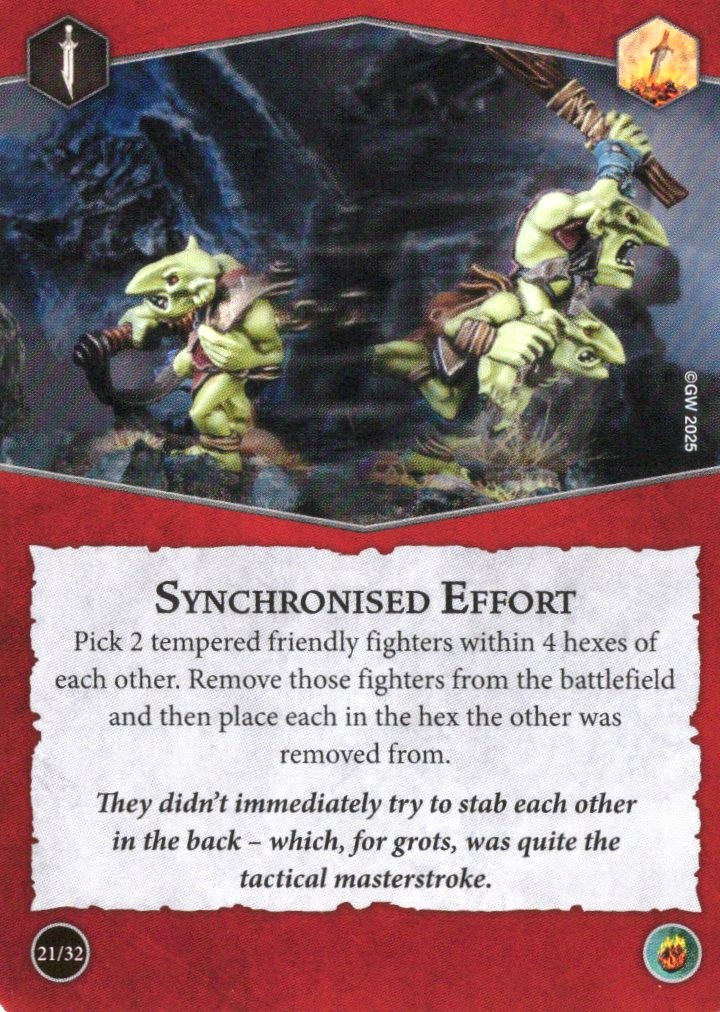
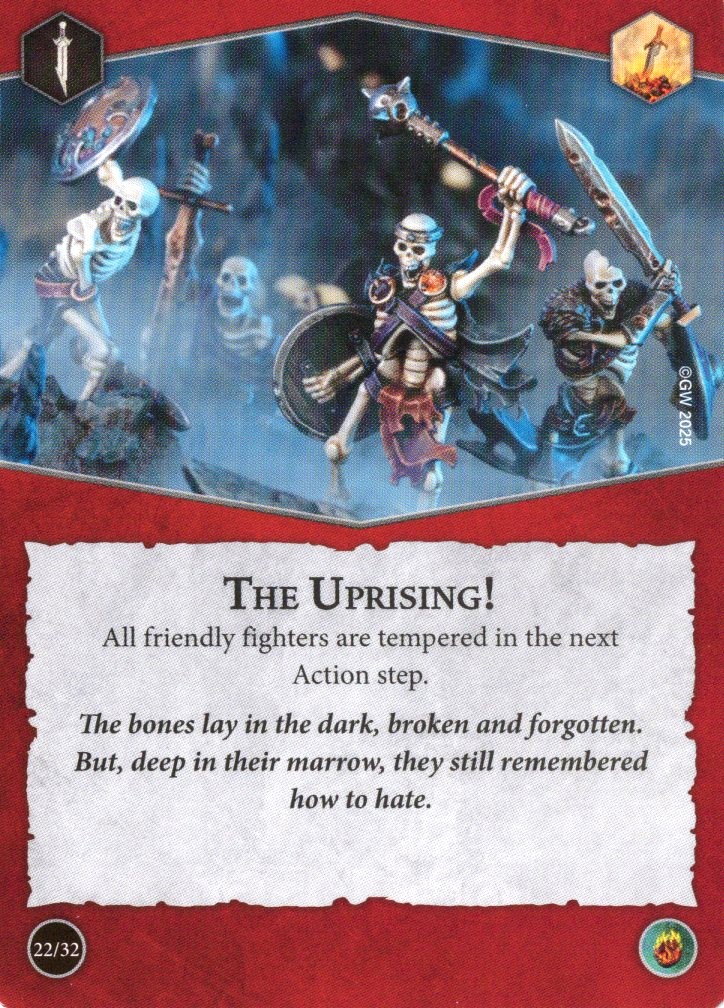
Synchronised Effort has echoes of Sudden-Warp Portal, but for tempered fighters. In cases where your warband has plenty of mobility, maybe you don’t need this, but for slower warbands and those where protecting a key fighter is a core part of the gameplan, I think this one is worth it. Niche, but noteworth, you can also use it to manipulate the Bounty you have holding objectives for a surprise Supremacy score. Again depends a bit on how many straightforwardly powerful cards you can slot into your ploys, but you could definitely find some spots in the game where this will provide value, even in cases as simple as getting an exposed, valuable fighter out of a bad situation.
Power Ceiling: 2, Consistency: 2, Universality: 2
The Uprising! tempers all of your fighters for a single action step. If I was already pondering whether it was worth a ploy slot to temper a fighter for an entire game, doing it for one action step (despite that it can affect multiple fighters) is not going to cut it. It doesn’t even do anything in the power step in which it is played to enable some cool combos like with our prior entry. I just can’t see ever using this card outside of Rivals. It’s a niche combo card at best, and you know how we feel about those.
Power Ceiling: 1, Consistency: 1, Universality: 1
Upgrades
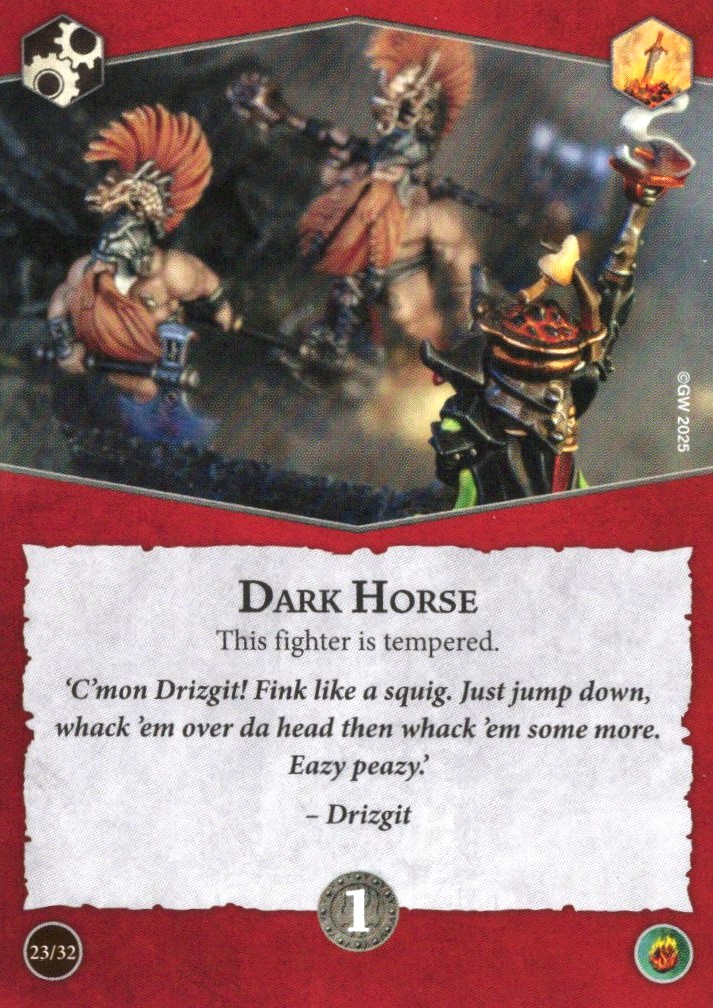
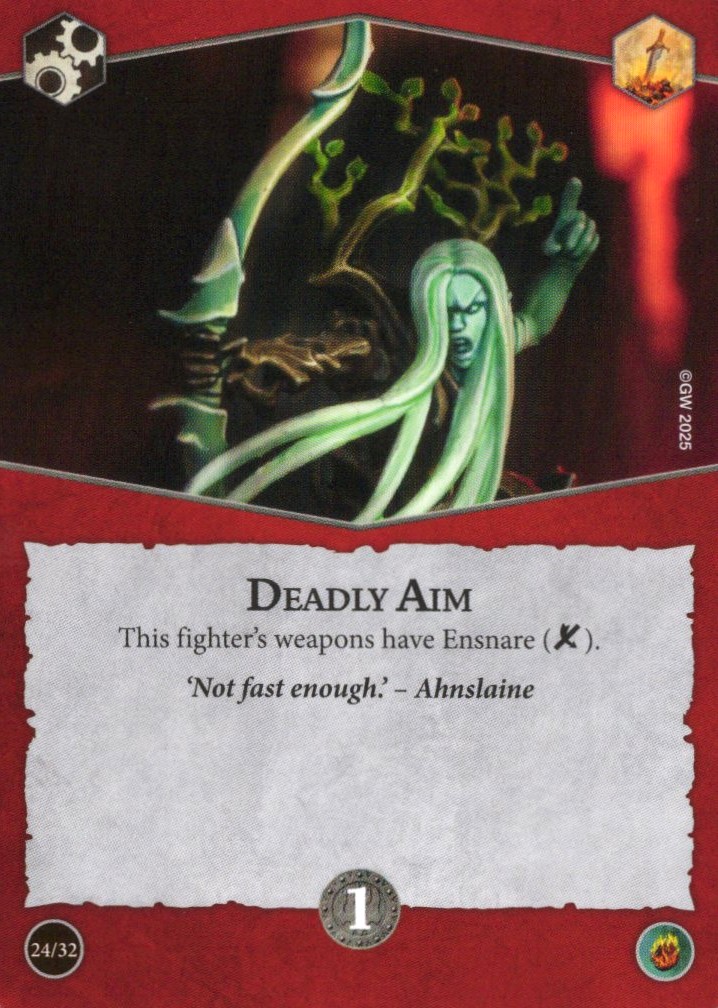
To start off the upgrades we have my preferred method of tempered support in Dark Horse. Not only will this avoid competition with your ploy slots, but having no other conditions than costing a glory to play is the most reliable way to keep a fighter tempered for the rest of the game (barring niche warscroll interactions like Vile Temptations). I like this one, it’s the perfect way to have that one fighter like Kainan or The Sepulchral Warden interact with the deck like the rest of your warband without having to invest all too heavily in pinging yourself. Even more essential for elite warbands trying to dip into this deck. Bit of a “fighter-specific” type of upgrade given that it would likely be useless to any fighter who is already natively tempered, but still solid.
Power Ceiling: 2, Consistency: 2, Universality: 2
Deadly Aim is back again… Yep…
Power Ceiling: 1, Consistency: 2, Universality: 2
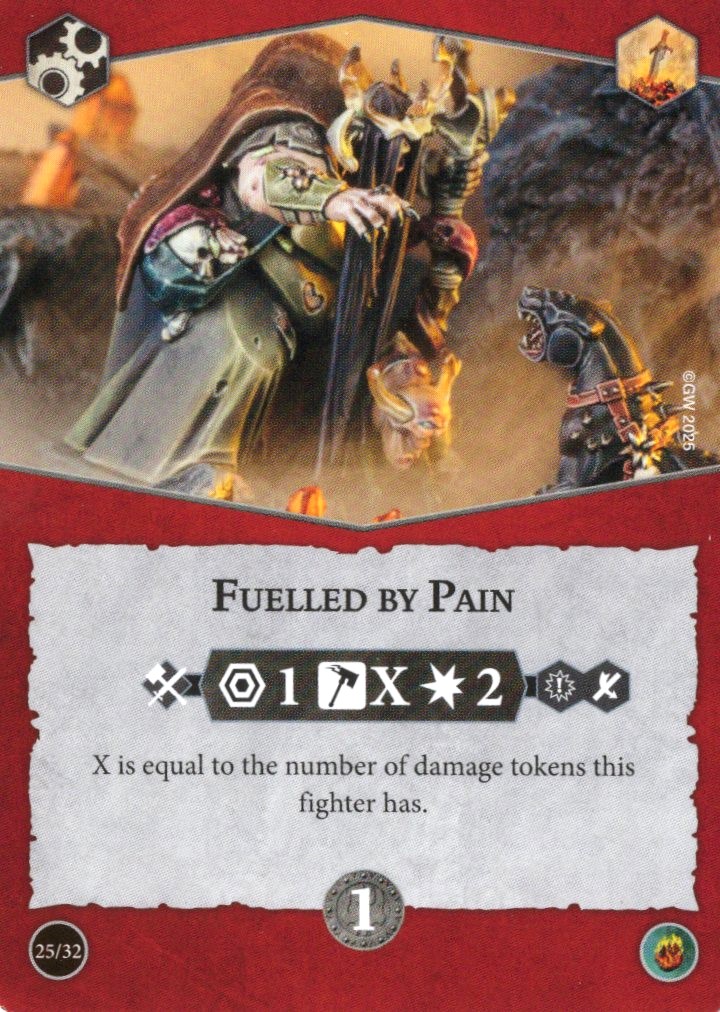
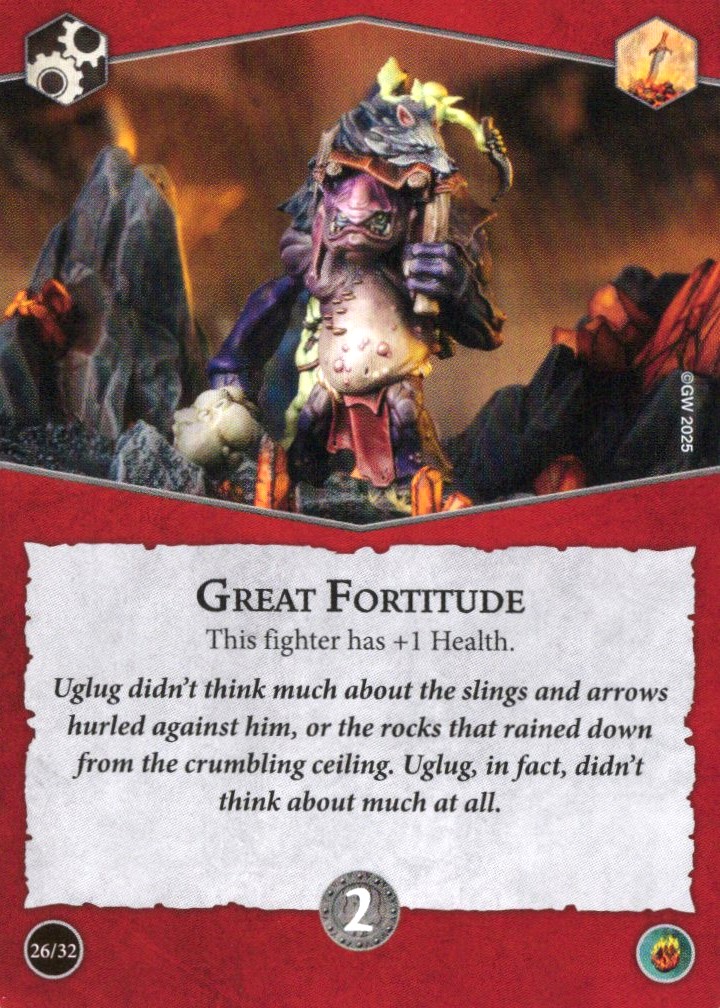
Fuelled by Pain is a weapon upgrade at 1R/XH/2D with critical ensnare where X = the number of damage tokens the equipped fighter has. This is also pretty awful I’m afraid. You don’t really see particularly significant value here until you’ve taken at least 3 damage and most fighters who have that much Health in the first place tend to have weapon profiles on their fighter card that are at least as good. You could get some funny accuracy on something like a vulnerable Blackpowder but even then I feel like damage is harder to come by than accuracy these days so I’d rather use his native melee weapon in most cases. Hard pass.
Power Ceiling: 1, Consistency: 1, Universality: 1
Great Fortitude is great of course, there’s not much more to say, every warband is happy to have extra Health on tap. Odds are you’re not giving this to your natively tempered fighters, but there’s always at least one key fighter (or one elite fighter) who you would like to survive that extra hit.
Power Ceiling: 3, Consistency: 3, Universality: 3
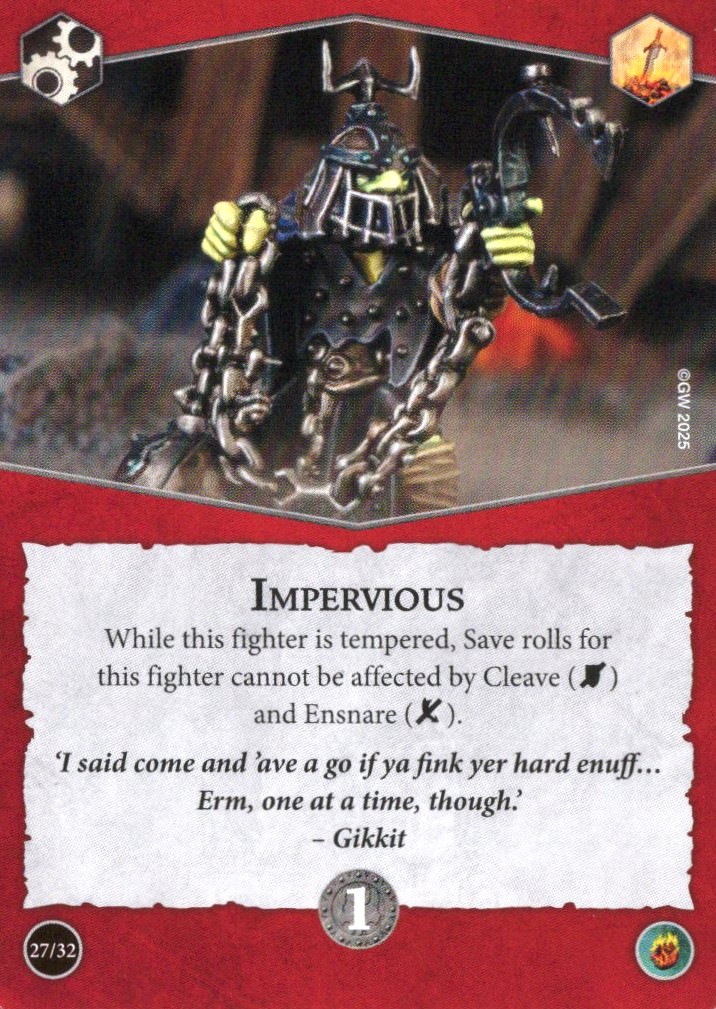
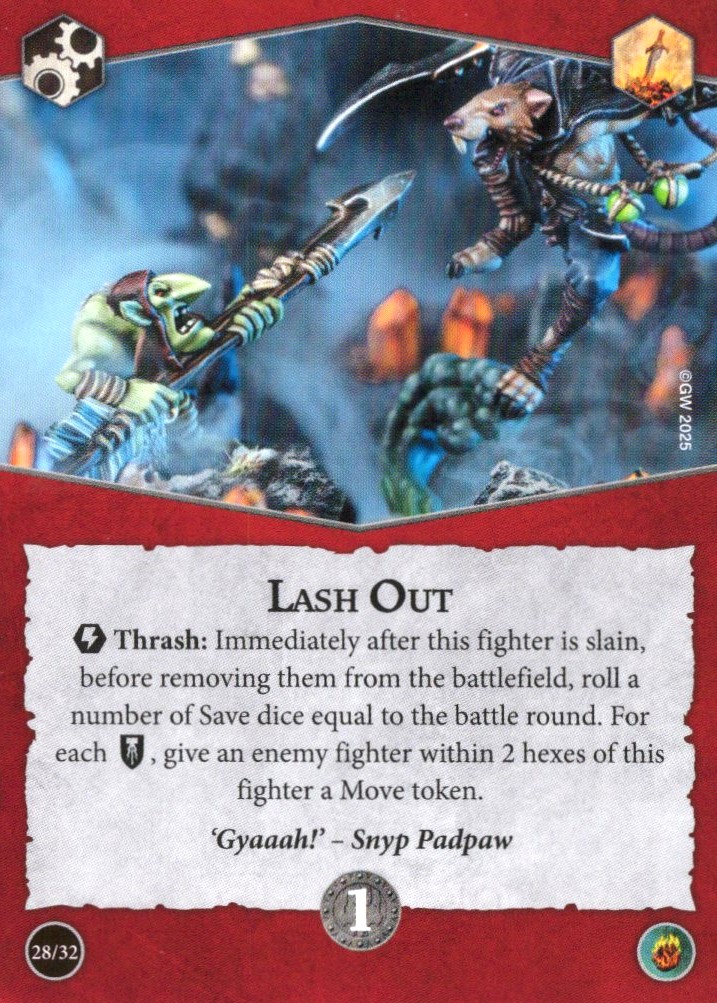
Similar sentiment goes for Impervious to some extent. While it’s no Bladecatcher (thank goodness), this definitely merits consideration as a defensive buff. It feels kind of like Brawler from Blazing Assault in that it will hover near the line of that 10th upgrade slot depending on which Rivals deck you ultimately pair with, but I like it well enough. It’ll just be a bit less generally applicable given that there are a number of warbands with neither cleave nor ensnare access.
Power Ceiling: 2, Consistency: 2, Universality: 2
Lash Out is another control tool in the deck that gives you a roll to try and hand out a Move token to an enemy fighter within 2 hexes once slain. Given that it is a telegraphed upgrade, I think this would have been totally fine without the dice roll but still not an autoinclude. As is, I just can’t see myself slotting this in very often unless, again, I am struggling to fill my upgrade slots.
Power Ceiling: 2, Consistency: 1, Universality: 2
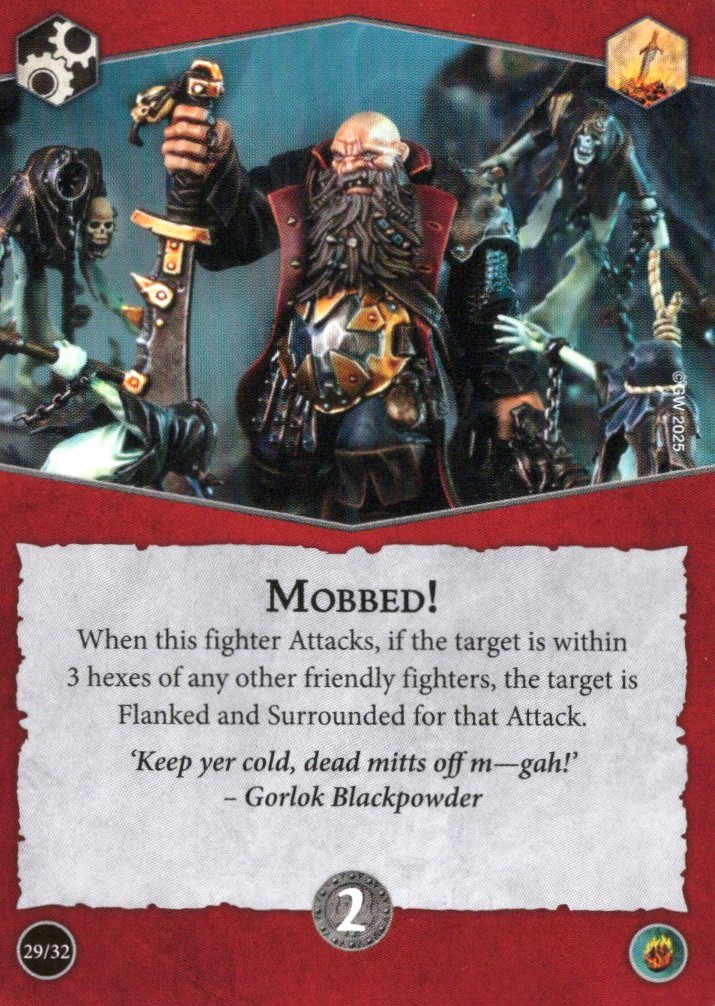
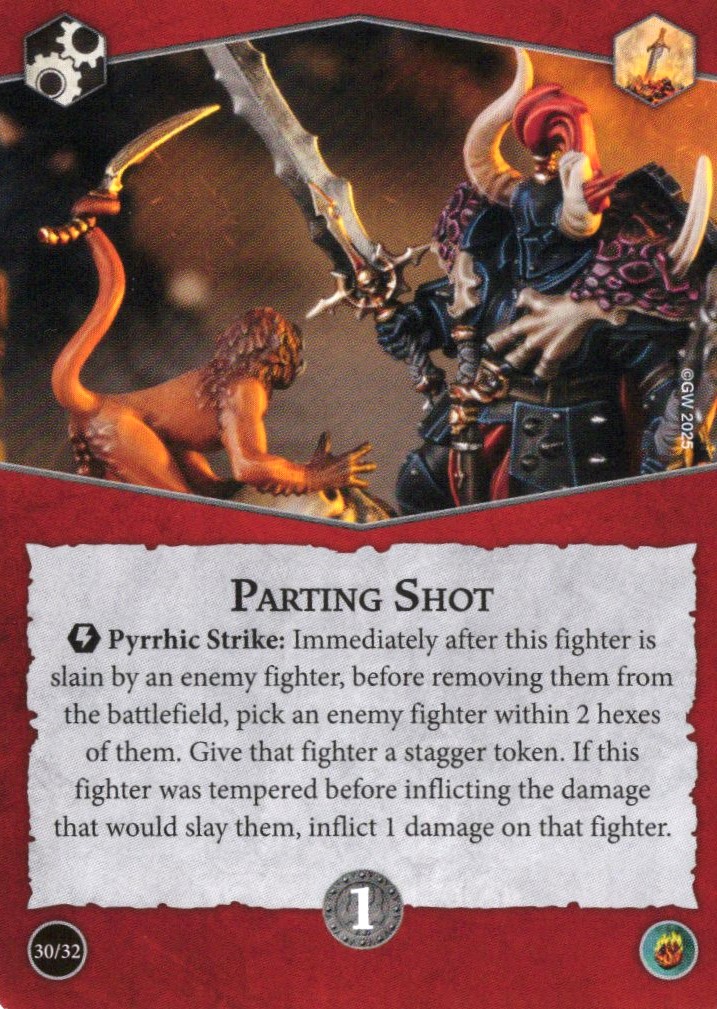
Mobbed! is an insanely good accuracy upgrade, particularly for horde warbands, although elites can find opportunities to make it work as well. If even one friendly fighter is within 3 hexes of the target of the attack, the target counts as both flanked and surrounded. While Zarbag’s Gitz once again deserve a special shoutout for their ease in accessing this effect, it is good for just about anyone. For a quick point of reference, 2H against 1S in this edition is a 50% chance to hit. Add flanked and surrounded and your odds of success skyrocket to a massive 83% on that same attack. Well worth it at 2 glory as this will often be an even larger accuracy boost than adding a die to your attack via something like Keen Eye. Definitely another card that increases the value of putting Brawler into your deck as well, which might already have made it in just to counter Hidden Aid.
Power Ceiling: 3, Consistency: 2, Universality: 2
Parting Shot is by far my preferred option of “hey it would maybe not be a great idea to kill this guy” upgrades in the deck. Stagger is neat enough but adding the ping on top (which will happen more often than not given what the deck is trying to do) is very good. Note that this only works if they are slain by an enemy fighter specifically, not a ping card, but without the undamaged and non-vulnerable restrictions, I think this pretty much has to make the cut, even if you might not be quite as excited about it as an elite warband since you expect you simply have tankier stats.
Power Ceiling: 3, Consistency: 2, Universality: 2
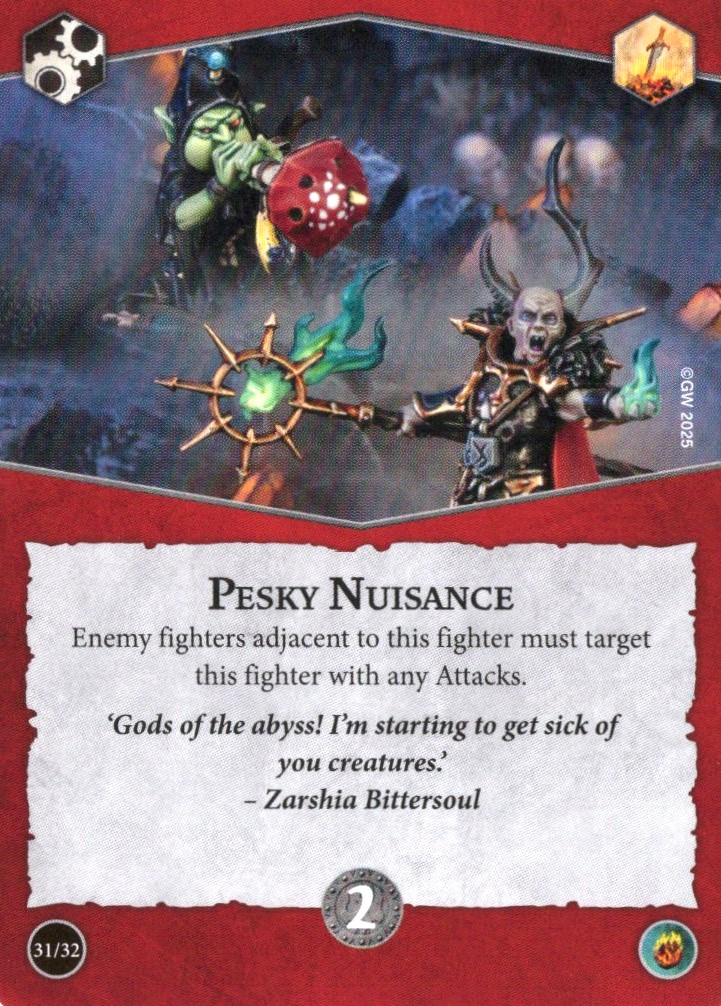
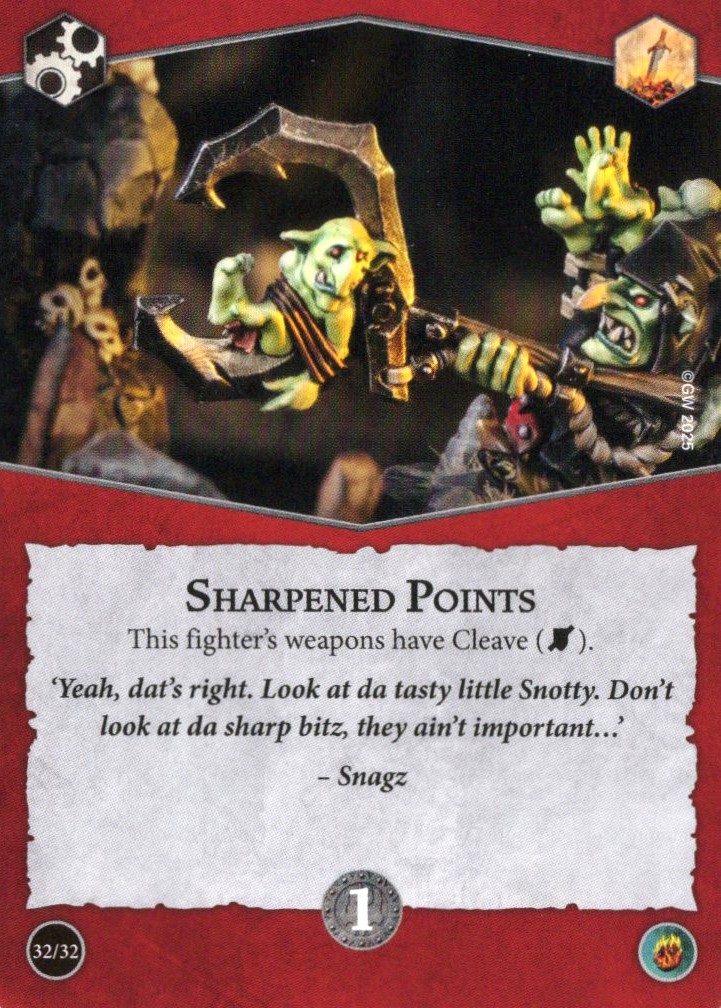
Pesky Nuisance forces your opponent to target the equipped fighter with any attacks when they are adjacent, which is obviously a phenomenally powerful effect if you can set it up. A bit steep of a cost at 2 glory, but the disruption potential is certainly high enough that it can hit that ceiling, especially if you can get it on a fighter with a high Save characteristic and/or low or 0 Bounty. That said, I think there’s a good chance it is better on paper than it is in practice. While the top end use cases are pretty devastating, odds are that your opponent has some way to position around you in cases where you’d want the ability to proc. It really only returns value in cases where fighters are charged out (with no means to push away and at least one other viable target) or can only charge adjacent to the equipped fighter to try and hit a specific other fighter. Being mindful of how many 2-glory upgrades I am trying to pack in to most decks, I do think there’s a chance this misses the cut a lot despite the chance for extremely significant disruption.
Power Ceiling: 3, Consistency: 1, Universality: 2
As usual, cleave is generally better than ensnare unless your warband already has a lot of it on their fighter cards, so Sharpened Points gets that extra little boost. A perfectly serviceable card that I think gets cut less frequently here than it does in Blazing Assault because there simply aren’t as many good upgrade options in this deck.
Power Ceiling: 2, Consistency: 2, Universality: 2
Conclusion
Overall, while I think this isn’t the kind of deck where you are likely to take over 50% of the cards into your Nemesis pairing, it offers some unique and powerful tools that we’ve not yet seen in the 2nd edition meta. Obviously, the deck is a huge boon for hordes who, pretty much besides Zarbag’s Gitz, have really been suffering against all of the elite hold and elite aggro in the meta. Speaking of, this deck is, of course, great for the Gitz (as if they needed more help), but also offers some much needed support for warbands like Grymwatch, Kainan’s Reapers, and Sepulchral Guard, among others. While it doesn’t fix all of the issues with these types of warbands, it does give them access to some very critical control tools while also adding enough offensive firepower to be worthwhile. However, I do think the deck lacking in the objective department, particularly with respect to end phase cards.
For that reason, I think it may be difficult to smash together with a deck like Blazing Assault despite the fact that you could build a really potent power deck from the combination of the two. I think the first and best natural pairing here is Pillage and Plunder, which can solve your objective deck woes pretty instantly while offering just enough power card support to fill some gaps in EotK. You should still be able to fit some tempering support in with that deck without drastically hurting your average card value compared to other pairings. After that, I think there is honestly a pretty steep drop off in options. Things like WaR and BA are probably your next best options given the synergy in the power decks, but I do think the objective decks in each case feel a bit weak to me. I would be inclined to give a slight edge to WaR given the scoring redundancy of Alone in the Dark and Calm Before the Storm, as well as the disruptive combination of Fireproof, Death Throes, and Spiteful Traps, but I can’t help but feel like that is more along the lines of the elite warband angle for the deck than it is for the hordes. Still, there’s a lot to play with here even if you’re not fully diving into the tempered aspects of the deck, so I’m excited to start building and seeing what the community can string together on this one.
Thanks for reading and we wish you the best of luck on YOUR Path to Glory!

